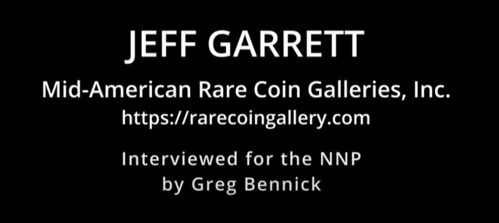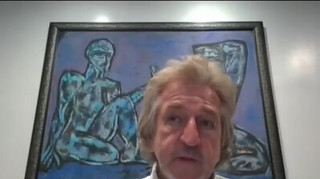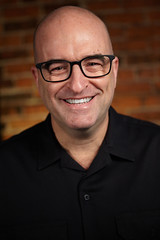
PREV ARTICLE
NEXT ARTICLE
FULL ISSUE
PREV FULL ISSUE
JEFF GARRETT INTERVIEW, PART ONEGreg Bennick's interview with dealer and longtime E-Sylum supporter Fred Weinberg was a wonderful look at the hobby and business of error coin collecting over the last half century. Greg has now embarked on a new series of interviews for the Newman Numismatic Portal, starting with Redbook Editor Jeff Garrett. Here's the first part, where Jeff tells how he got started in the hobby. -Editor Greg Bennick: My name is Greg Bennick, and I'm here today with Jeff Garrett. We're going to answer a few questions about his career and whatnot. And Jeff, let's just dive right in. Thanks so much for taking the time. I really appreciate it. Jeff Garrett: Well thanks Greg for having me today. Greg Bennick: Absolutely. So tell me, how did you get your start in coins? You know, your bio is online, many people know the things that you have done. I'm almost always more curious about the human element behind the bio. So how did you get your start in coins and what year was that and how did that go about?
In Clearwater, Florida, back in the late sixties, early seventies, there were a lot of coin clubs. There were probably five or six in the area. So, basically every week there was a coin club meeting somewhere in one of the towns. And I was really lucky that I had some mentors that I guess they saw tin me hat I really love coins and I was a young kid and by the time I was 14 or 15, I was considered like a whiz kid with it. So, they would come and pick me up. My dad traveled out for work so he was never home, but they would pick me up and take me to the coin club meetings. And then afterwards they'd all meet at Denny's and I'd get to talk coins with them and things like that. And then also in that area was a Clearwater coin show, which was kind of famous in Florida, it used to be a really big deal and we would go to that once a year. And so, it was my luck of growing up in the Clearwater, Tampa area that I was able to have some mentors that really kind of got me into it, amd gave me opportunities to learn. I would ride my bike to a coin shop in Dunedin, Florida that a guy named Ed French ran. And I would help him flip coins and do things you do in a coin shop. And it was a typical hole in the wall place. But I was just really in the right place at the right time to be exposed to coins, so it was really a lucky time. Greg Bennick: That's amazing. Now what do you think it is that defines a whiz kid at 14 or 15? What was it about you that made you stand out from all the other kids? Was it your ability to memorize, was it your grading ability at the time? What do you think it was? Jeff Garrett: That's a good question. You know, it was really kind of a combination of those. So grading, I was really good at grading, like really quickly. I had a really good memory for coins. I still do. I can't remember what I had for lunch yesterday, but I can remember a coin that I sold a year ago. Somehow, I have like a photographic memory for coins, but it doesn't imply to anything else, so it's really a strange thing. And also, I was really good with counterfeit detection, for some reason I could identify counterfeit gold. So, by the time I was 15, people were asking me for advice. It was kind of funny. And also fairly soon I became a pretty good trader. I could see a coin and figure out what it was worth. And I kind of kid people because now I'm editor of Red Book and back in the seventies, the Red Book was really an important thing. And so I did everything I could and memorized the Red Book. And then another thing, I started understanding early on that information was really key. And I don't know if education's the right word for it then, but I was like, the more you know, the more you can make, kind of thing. I figured that out really fast. And I remember when David Aker's books came out in the seventies and I was like, wow, this is really great information. You could look at and memorize the Red Book, but that was mintages and prices, but Dave Aker's books were the first one that had a narrative about this coin, maybe it's listed in the Red Book, but it's actually known in mint state and that kind of stuff. So early on I just realized the more you know the more you can make. And I kind of made that a staple of how I did business. Greg Bennick: I'm not Gregsplaining this to you, as you know this already, but those little pieces of information make the difference. If you know that the Red Book says this, but this coin is unknown in Mint State and that coin comes up for auction and it happens to be in Mint State, that little piece of information is huge. I mean it's absolutely immense. Jeff Garrett: Yeah, it was big. And then long later on, I actually learned that there were ways of finding information too. You know, many years later John Dannreuther and I started compiling auction records. We were one of the first ones that did that. We would go in, we started a database and we eventually sold it to PCGS. And now it's part of what everyone uses. Now people use auction records for pricing pretty much more than price guides. So yeah, I remember we had started that project, we hired college students to take auction catalogs and put them in an Excel file. And then later we had to use more sophisticated databases. But I remember buying an 1841 Quarter Eagle, and I saw the auction records that they were all bringing twice what they were bringing in the catalog and I capitalized on that at a coin show. I was like, wow, we gotta really amp it up. So we hired more people and it ended that even today, now it's the way most people price coins; prices realized. Greg Bennick: How many auction records did these college students type in, do you think? Jeff Garrett: Oh, it was tens of thousands. I remember we eventually got beyond Excel, and I have to ask John which database we went to next, but he was more the tech guy and we ended up having to buy something else that was bigger, that could control more data. And up until about 10 years or so ago, a lot of it was done by hand. It's in the last 10 years that now the auction companies, they download it into databases and it goes up to the Collector's Universe who gets it, and then Greysheet gets it. And so that information now is consolidated and you can get it at your fingertips.
Greg Bennick: You know that you've taken on a large coin task when you go past the
capability of Microsoft. When Excel just isn't enough and you're like,
Jeff Garrett: You know, it's kinda like a slow boil, like you put a frog in a boiling water
and he doesn't know it because it goes so slowly. So, my exposure to Red Book was really a
slow process. I was a coin trader for most of my career until about 15 or 20 years ago. And I
had this idea about the 100 Greatest Coins. Everybody's like, Then I started working with Ken Bressett and so we worked on that. And I would do every year for a few years, I would do the pricing for gold, kinda what they call finalizing, where they have contributors, but someone has to take the contributors prices and put in the final final price. And even then, I was putting in the prices, but Ken Bressett would overlook it and he would be the ultimate finalizer, but I did 95% of the work. So, we did that and then eventually Ken was wanting to slow down a little bit, I guess he was getting in his late eighties, and he said he wanted to finally slow down a little bit. So I started doing more of the book, and then eventually I was doing sort of like an apprenticeship. I was doing the entire book, but it was still as I guess a pricing editor, I think what they called me was a valuation editor is what I was called so I did that. And I love the Red Book and I've used it as a tool for my whole life, so it's been something I really care about. And so eventually worked on it some more. And then at some point I got the big honor of having my name moved to the front of the book as a valuation editor with Dave Bowers as research editor and Ken Bressett as editor. That was a big achievement for me numismatically, so I was pretty happy about that.
And then I guess 2019 I think it was, so it's about three or four years ago now, Ken Bressett
was 91 or 92 and still walking four miles a day, but he was wanting to actually really retire.
So I took on the job of doing the entire Red Book as a senior editor. So now I'm senior
editor, Ken Bressett is still fairly active as far as you know, we have a question if something
comes up, or if someone questions a mintage on a coin, we'll still be like,
So, he still has an amazing memory, and he'll turn 95 this year and that's pretty amazing. So,
my involvement with Red Book was an evolving process and it's been enjoyable. I like it. I
like everything except for the last month where I have to really put it all together, which is
like a big giant amount of work. We have a good contributor system. Someone told me a
quote once that I really like from Mark Twain. Someone asked Mark Twain if he enjoys
writing, and he said,
To watch the complete interview on NNP, see:
To read the earlier E-Sylum article, see:
Wayne Homren, Editor The Numismatic Bibliomania Society is a non-profit organization promoting numismatic literature. See our web site at coinbooks.org. To submit items for publication in The E-Sylum, write to the Editor at this address: whomren@gmail.com To subscribe go to: https://my.binhost.com/lists/listinfo/esylum All Rights Reserved. NBS Home Page Contact the NBS webmaster 
|



